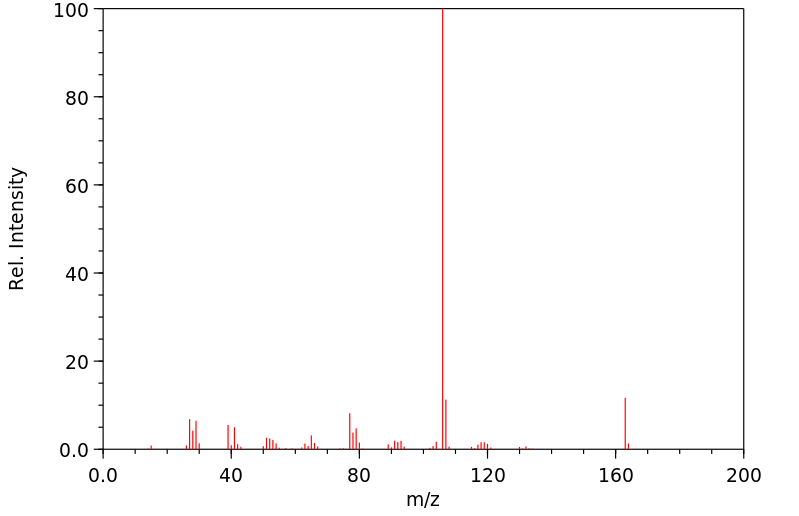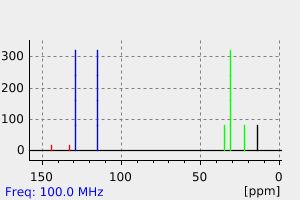4-正戊基苯胺 | 33228-44-3
中文名称
4-正戊基苯胺
中文别名
4-戊基苯胺;4-n-戊基苯胺
英文名称
4-pentylaniline
英文别名
p-pentylaniline;4-n-pentylaniline;4-pentylphenylamine
CAS
33228-44-3
化学式
C11H17N
mdl
MFCD00007926
分子量
163.263
InChiKey
DGFTWBUZRHAHTH-UHFFFAOYSA-N
BEILSTEIN
——
EINECS
——
-
物化性质
-
计算性质
-
ADMET
-
安全信息
-
SDS
-
制备方法与用途
-
上下游信息
-
文献信息
-
表征谱图
-
同类化合物
-
相关功能分类
-
相关结构分类
物化性质
-
熔点:46.25°C (estimate)
-
沸点:130 °C
-
密度:0.919 g/mL at 25 °C(lit.)
-
闪点:>230 °F
-
稳定性/保质期:
避免使用强氧化剂。
计算性质
-
辛醇/水分配系数(LogP):3.4
-
重原子数:12
-
可旋转键数:4
-
环数:1.0
-
sp3杂化的碳原子比例:0.454
-
拓扑面积:26
-
氢给体数:1
-
氢受体数:1
安全信息
-
TSCA:Yes
-
危险品标志:Xi
-
安全说明:S26,S36
-
危险类别码:R36/37/38
-
WGK Germany:3
-
海关编码:2921420090
-
危险性防范说明:P261,P305+P351+P338
-
危险性描述:H315,H319,H335
-
储存条件:请将贮藏器保持密封,并存放在阴凉干燥处。同时,确保工作环境有良好的通风或排气装置。
SDS
4-戊基苯胺 修改号码:5
模块 1. 化学品
产品名称: 4-Amylaniline
修改号码: 5
模块 2. 危险性概述
GHS分类
物理性危害 未分类
健康危害
皮肤腐蚀/刺激 第2级
严重损伤/刺激眼睛 2A类
环境危害 未分类
GHS标签元素
图标或危害标志
信号词 警告
危险描述 造成皮肤刺激
造成严重眼刺激
防范说明
[预防] 处理后要彻底清洗双手。
穿戴防护手套/护目镜/防护面具。
[急救措施] 眼睛接触:用水小心清洗几分钟。如果方便,易操作,摘除隐形眼镜。继续冲洗。
眼睛接触:求医/就诊
皮肤接触:用大量肥皂和水轻轻洗。
若皮肤刺激:求医/就诊。
脱掉被污染的衣物,清洗后方可重新使用。
模块 3. 成分/组成信息
单一物质/混和物 单一物质
化学名(中文名): 4-戊基苯胺
百分比: >97.0%(GC)
CAS编码: 33228-44-3
俗名: 4-PeNTylaniline
4-戊基苯胺 修改号码:5
模块 3. 成分/组成信息
分子式: C11H17N
模块 4. 急救措施
吸入: 将受害者移到新鲜空气处,保持呼吸通畅,休息。若感不适请求医/就诊。
皮肤接触: 立即去除/脱掉所有被污染的衣物。用大量肥皂和水轻轻洗。
若皮肤刺激或发生皮疹:求医/就诊。
眼睛接触: 用水小心清洗几分钟。如果方便,易操作,摘除隐形眼镜。继续清洗。
如果眼睛刺激:求医/就诊。
食入: 若感不适,求医/就诊。漱口。
紧急救助者的防护: 救援者需要穿戴个人防护用品,比如橡胶手套和气密性护目镜。
模块 5. 消防措施
合适的灭火剂: 干粉,泡沫,二氧化碳
不适用的灭火剂: 水(有可能扩大灾情。)
特殊危险性: 小心,燃烧或高温下可能分解产生毒烟。
特定方法: 从上风处灭火,根据周围环境选择合适的灭火方法。
非相关人员应该撤离至安全地方。
周围一旦着火:如果安全,移去可移动容器。
消防员的特殊防护用具: 灭火时,一定要穿戴个人防护用品。
模块 6. 泄漏应急处理
个人防护措施,防护用具, 使用个人防护用品。远离溢出物/泄露处并处在上风处。确保足够通风。
紧急措施: 泄露区应该用安全带等圈起来,控制非相关人员进入。
环保措施: 防止进入下水道。
控制和清洗的方法和材料: 用合适的吸收剂(如:旧布,干砂,土,锯屑)吸收泄漏物。一旦大量泄漏,筑堤控
制。附着物或收集物应该立即根据合适的法律法规废弃处置。
模块 7. 操作处置与储存
处理
技术措施: 在通风良好处进行处理。穿戴合适的防护用具。防止烟雾产生。处理后彻底清洗双手
和脸。
注意事项: 如果蒸气或浮质产生,使用通风、局部排气。
操作处置注意事项: 避免接触皮肤、眼睛和衣物。
贮存
储存条件: 保持容器密闭。存放于凉爽、阴暗处。
存放于惰性气体环境中。
远离不相容的材料比如氧化剂存放。
气敏
包装材料: 依据法律。
模块 8. 接触控制和个体防护
工程控制: 尽可能安装封闭体系或局部排风系统,操作人员切勿直接接触。同时安装淋浴器和洗
眼器。
个人防护用品
呼吸系统防护: 防毒面具。依据当地和政府法规。
手部防护: 防护手套。
眼睛防护: 安全防护镜。如果情况需要,佩戴面具。
皮肤和身体防护: 防护服。如果情况需要,穿戴防护靴。
4-戊基苯胺 修改号码:5
模块 9. 理化特性
液体
外形(20°C):
外观: 透明
颜色: 极淡的黄色-黄红色
气味: 无资料
pH: 无数据资料
熔点: 无资料
沸点/沸程 265 °C
闪点: 无资料
爆炸特性
爆炸下限: 无资料
爆炸上限: 无资料
密度: 0.93
溶解度:
[水] 无资料
[其他溶剂] 无资料
模块 10. 稳定性和反应性
化学稳定性: 一般情况下稳定。
危险反应的可能性: 未报道特殊反应性。
须避免接触的物质 氧化剂
危险的分解产物: 一氧化碳, 二氧化碳, 氮氧化物 (NOx)
模块 11. 毒理学信息
急性毒性: 无资料
对皮肤腐蚀或刺激: 无资料
对眼睛严重损害或刺激: 无资料
生殖细胞变异原性: 无资料
致癌性:
IARC = 无资料
NTP = 无资料
生殖毒性: 无资料
模块 12. 生态学信息
生态毒性:
鱼类: 无资料
甲壳类: 无资料
藻类: 无资料
残留性 / 降解性: 无资料
潜在生物累积 (BCF): 无资料
土壤中移动性
log水分配系数: 无资料
土壤吸收系数 (Koc): 无资料
亨利定律 无资料
constaNT(PaM3/mol):
模块 13. 废弃处置
如果可能,回收处理。请咨询当地管理部门。建议在装有后燃和洗涤装置的化学焚烧炉中焚烧。废弃处置时请遵守
国家、地区和当地的所有法规。
4-戊基苯胺 修改号码:5
模块 14. 运输信息
联合国分类: 与联合国分类标准不一致
UN编号: 未列明
模块 15. 法规信息
《危险化学品安全管理条例》(2002年1月26日国务院发布,2011年2月16日修订): 针对危险化学品的安全使用、
生产、储存、运输、装卸等方面均作了相应的规定。
模块16 - 其他信息
N/A
模块 1. 化学品
产品名称: 4-Amylaniline
修改号码: 5
模块 2. 危险性概述
GHS分类
物理性危害 未分类
健康危害
皮肤腐蚀/刺激 第2级
严重损伤/刺激眼睛 2A类
环境危害 未分类
GHS标签元素
图标或危害标志
信号词 警告
危险描述 造成皮肤刺激
造成严重眼刺激
防范说明
[预防] 处理后要彻底清洗双手。
穿戴防护手套/护目镜/防护面具。
[急救措施] 眼睛接触:用水小心清洗几分钟。如果方便,易操作,摘除隐形眼镜。继续冲洗。
眼睛接触:求医/就诊
皮肤接触:用大量肥皂和水轻轻洗。
若皮肤刺激:求医/就诊。
脱掉被污染的衣物,清洗后方可重新使用。
模块 3. 成分/组成信息
单一物质/混和物 单一物质
化学名(中文名): 4-戊基苯胺
百分比: >97.0%(GC)
CAS编码: 33228-44-3
俗名: 4-PeNTylaniline
4-戊基苯胺 修改号码:5
模块 3. 成分/组成信息
分子式: C11H17N
模块 4. 急救措施
吸入: 将受害者移到新鲜空气处,保持呼吸通畅,休息。若感不适请求医/就诊。
皮肤接触: 立即去除/脱掉所有被污染的衣物。用大量肥皂和水轻轻洗。
若皮肤刺激或发生皮疹:求医/就诊。
眼睛接触: 用水小心清洗几分钟。如果方便,易操作,摘除隐形眼镜。继续清洗。
如果眼睛刺激:求医/就诊。
食入: 若感不适,求医/就诊。漱口。
紧急救助者的防护: 救援者需要穿戴个人防护用品,比如橡胶手套和气密性护目镜。
模块 5. 消防措施
合适的灭火剂: 干粉,泡沫,二氧化碳
不适用的灭火剂: 水(有可能扩大灾情。)
特殊危险性: 小心,燃烧或高温下可能分解产生毒烟。
特定方法: 从上风处灭火,根据周围环境选择合适的灭火方法。
非相关人员应该撤离至安全地方。
周围一旦着火:如果安全,移去可移动容器。
消防员的特殊防护用具: 灭火时,一定要穿戴个人防护用品。
模块 6. 泄漏应急处理
个人防护措施,防护用具, 使用个人防护用品。远离溢出物/泄露处并处在上风处。确保足够通风。
紧急措施: 泄露区应该用安全带等圈起来,控制非相关人员进入。
环保措施: 防止进入下水道。
控制和清洗的方法和材料: 用合适的吸收剂(如:旧布,干砂,土,锯屑)吸收泄漏物。一旦大量泄漏,筑堤控
制。附着物或收集物应该立即根据合适的法律法规废弃处置。
模块 7. 操作处置与储存
处理
技术措施: 在通风良好处进行处理。穿戴合适的防护用具。防止烟雾产生。处理后彻底清洗双手
和脸。
注意事项: 如果蒸气或浮质产生,使用通风、局部排气。
操作处置注意事项: 避免接触皮肤、眼睛和衣物。
贮存
储存条件: 保持容器密闭。存放于凉爽、阴暗处。
存放于惰性气体环境中。
远离不相容的材料比如氧化剂存放。
气敏
包装材料: 依据法律。
模块 8. 接触控制和个体防护
工程控制: 尽可能安装封闭体系或局部排风系统,操作人员切勿直接接触。同时安装淋浴器和洗
眼器。
个人防护用品
呼吸系统防护: 防毒面具。依据当地和政府法规。
手部防护: 防护手套。
眼睛防护: 安全防护镜。如果情况需要,佩戴面具。
皮肤和身体防护: 防护服。如果情况需要,穿戴防护靴。
4-戊基苯胺 修改号码:5
模块 9. 理化特性
液体
外形(20°C):
外观: 透明
颜色: 极淡的黄色-黄红色
气味: 无资料
pH: 无数据资料
熔点: 无资料
沸点/沸程 265 °C
闪点: 无资料
爆炸特性
爆炸下限: 无资料
爆炸上限: 无资料
密度: 0.93
溶解度:
[水] 无资料
[其他溶剂] 无资料
模块 10. 稳定性和反应性
化学稳定性: 一般情况下稳定。
危险反应的可能性: 未报道特殊反应性。
须避免接触的物质 氧化剂
危险的分解产物: 一氧化碳, 二氧化碳, 氮氧化物 (NOx)
模块 11. 毒理学信息
急性毒性: 无资料
对皮肤腐蚀或刺激: 无资料
对眼睛严重损害或刺激: 无资料
生殖细胞变异原性: 无资料
致癌性:
IARC = 无资料
NTP = 无资料
生殖毒性: 无资料
模块 12. 生态学信息
生态毒性:
鱼类: 无资料
甲壳类: 无资料
藻类: 无资料
残留性 / 降解性: 无资料
潜在生物累积 (BCF): 无资料
土壤中移动性
log水分配系数: 无资料
土壤吸收系数 (Koc): 无资料
亨利定律 无资料
constaNT(PaM3/mol):
模块 13. 废弃处置
如果可能,回收处理。请咨询当地管理部门。建议在装有后燃和洗涤装置的化学焚烧炉中焚烧。废弃处置时请遵守
国家、地区和当地的所有法规。
4-戊基苯胺 修改号码:5
模块 14. 运输信息
联合国分类: 与联合国分类标准不一致
UN编号: 未列明
模块 15. 法规信息
《危险化学品安全管理条例》(2002年1月26日国务院发布,2011年2月16日修订): 针对危险化学品的安全使用、
生产、储存、运输、装卸等方面均作了相应的规定。
模块16 - 其他信息
N/A
上下游信息
-
上游原料
中文名称 英文名称 CAS号 化学式 分子量 戊基苯 pentylbenzene 538-68-1 C11H16 148.248 1-硝基-4-戊基苯 1-(4-nitrophenyl)pentane 95857-32-2 C11H15NO2 193.246 —— N-(4-pentylphenyl)acetamide 20330-52-3 C13H19NO 205.3 4-氯戊基苯 1-chloro-4-pentylbenzene 79098-20-7 C11H15Cl 182.693 4-戊基苯乙炔 1-ethynyl-4-(n-pentyl)benzene 79887-10-8 C13H16 172.27 -
下游产品
中文名称 英文名称 CAS号 化学式 分子量 4-戊基苯异氰酸酯 4-pentyl-phenyl isocyanate 121503-84-2 C12H15NO 189.257 —— 4-n-pentyl-4'-n-propylazobenzene 137532-44-6 C20H26N2 294.44 —— N-(4-pentylphenyl)acetamide 20330-52-3 C13H19NO 205.3 —— 2-chloro-4-pentylaniline —— C11H16ClN 197.708 对戊基溴苯 4-pentylbromobenzene 51554-95-1 C11H15Br 227.144 —— Terephtalyliden-bis(4-n-pentyl-anilin) 65726-56-9 C30H36N2 424.629 4-戊基苯乙炔 1-ethynyl-4-(n-pentyl)benzene 79887-10-8 C13H16 172.27 1-碘-4-正戊烷基苯 1-iodo-4-pentylbenzene 85017-60-3 C11H15I 274.145 —— N-(4-n-Pentylbenzyliden)-4'-n-pentylanilin 60236-96-6 C23H31N 321.506
反应信息
-
作为反应物:参考文献:名称:235.烷基苯胺的重排。第八部分 大型团体的迁移摘要:DOI:10.1039/jr9370001119
-
作为产物:参考文献:名称:Liquid-Crystalline Polymorphism of Symmetrical Azobananas: bis(4-(4-alkylphenyl)azophenyl) 2-nitroisophtalates摘要:In this paper we present a series of novel compounds, bis(4-(4-alkylphenyl)azophenyl) 2-nitroisophtalates, which exhibit nematic and banana-type liquid-crystalline phases. The alkyl chain length varies from 1 to 18 carbons. The first ten members of this series exhibit nematic phase. The last eleven compounds exhibit banana-type liquid crystalline phases. The propyl and pentyl derivatives have extra second type of banana mesophase.DOI:10.1080/15421400903065754
文献信息
-
Compositions for Treatment of Cystic Fibrosis and Other Chronic Diseases申请人:Vertex Pharmaceuticals Incorporated公开号:US20150231142A1公开(公告)日:2015-08-20The present invention relates to pharmaceutical compositions comprising an inhibitor of epithelial sodium channel activity in combination with at least one ABC Transporter modulator compound of Formula A, Formula B, Formula C, or Formula D. The invention also relates to pharmaceutical formulations thereof, and to methods of using such compositions in the treatment of CFTR mediated diseases, particularly cystic fibrosis using the pharmaceutical combination compositions.
-
CHLORO-PYRAZINE CARBOXAMIDE DERIVATIVES WITH EPITHELIAL SODIUM CHANNEL BLOCKING ACTIVITY申请人:Parion Sciences, Inc.公开号:US20140171447A1公开(公告)日:2014-06-19This invention provides compounds of the formula I: and their pharmaceutically acceptable salts, useful as sodium channel blockers, compositions containing the same, therapeutic methods and uses for the same and processes for preparing the same.这项发明提供了式I的化合物及其药用盐,可用作钠通道阻滞剂,包含这些化合物的组合物,以及用于这些化合物的治疗方法和用途,以及制备这些化合物的方法。
-
Antimitotic Antitumor Agents: Synthesis, Structure−Activity Relationships, and Biological Characterization of <i>N</i>-Aryl-<i>N</i>‘-(2-chloroethyl)ureas as New Selective Alkylating Agents作者:Emmanuelle Mounetou、Jean Legault、Jacques Lacroix、René C-GaudreaultDOI:10.1021/jm0010264日期:2001.3.1series of N-aryl-N'-(2-chloroethyl)ureas (CEUs) and derivatives were synthesized and evaluated for antiproliferative activity against a wide panel of tumor cell lines. Systematic structure--activity relationship (SAR) studies indicated that: (i) a branched alkyl chain or a halogen at the 4-position of the phenyl ring or a fluorenyl/indanyl group, (ii) an exocyclic urea function, and (iii) a N'-2-chloroethyl合成了一系列的N-芳基-N'-(2-氯乙基)脲(CEU)及其衍生物,并评估了其对多种肿瘤细胞系的抗增殖活性。系统结构-活性关系(SAR)研究表明:(i)苯环或芴基/茚满基4位上的支链烷基链或卤素,(ii)外环脲官能团,和(iii) )需要N'-2-氯乙基部分以确保明显的细胞毒性。诸如免疫荧光显微镜等生物学实验证实,这些有前途的化合物通过β-微管蛋白的选择性烷基化诱导微管解聚,从而改变了细胞骨架。随后的评估表明,有效的CEU是弱烷基化剂,是非DNA破坏剂,并且不与谷胱甘肽或谷胱甘肽还原酶的硫醇功能相互作用。因此,CEU是新型抗有丝分裂剂的一部分。最后,在评估的一系列CEU中,选择了化合物12、15、16和27用于进一步的体内试验。
-
Compounds Which Modulate The CB2 Receptor申请人:Berry Angela公开号:US20100009964A1公开(公告)日:2010-01-14Compounds of formula (I) are disclosed. Compounds according to the and are useful for treating inflammation. Those compounds which are agonists are additionally useful for treating pain.公式(I)的化合物已被披露。根据该公式的化合物对治疗炎症有用。那些是激动剂的化合物还额外适用于治疗疼痛。
-
Effect on <i>K</i><sub>ATP</sub> Channel Activation Properties and Tissue Selectivity of the Nature of the Substituent in the 7- and the 3-Position of 4<i>H</i>-1,2,4-Benzothiadiazine 1,1-Dioxides作者:Stéphane Boverie、Marie-Hélène Antoine、Fabian Somers、Bénédicte Becker、Sophie Sebille、Raogo Ouedraogo、Stéphane Counerotte、Bernard Pirotte、Philippe Lebrun、Pascal de TullioDOI:10.1021/jm0311339日期:2005.5.1structurally related to previously described potassium channel openers such as the benzothiadiazine dioxide BPDZ 73, were tested as putative K(ATP) channel activators on the pancreatic endocrine tissue and on the vascular smooth muscle tissue. The nature of the substituent introduced in the 7-position as well as the nature of the alkylamino side chain in the 3-position strongly affected both potency and tissue本工作探讨了在7位上不同取代的3-烷基氨基-4H-1,2,4-苯并噻二嗪1,1-二氧化物。那些与先前描述的钾通道开放剂(例如二氧化苯并噻二嗪BPDZ 73)在结构上相关的化合物已在胰腺内分泌组织和血管平滑肌组织上作为推定的K(ATP)通道活化剂进行了测试。在7位引入的取代基的性质以及在3位引入的烷基氨基侧链的性质强烈影响4H-1,2,4-苯并噻二嗪1,1-二氧化物的效能和组织选择性。因此,在7位上带有甲基或甲氧基或在该位置上没有取代基并带有乙基,异丙基的化合物,发现3-位的环丁基或环丁基氨基是有效的和选择性的胰岛素从大鼠胰腺B细胞(即10a,10b,12b,12d,22c)释放的抑制剂。相反,3-烷基氨基-7-三氟甲基-(20a-c)和3-烷基氨基-7-戊基-4H-1,2,4-苯并噻二嗪1,1-二氧化物(11a,b)在表面上表现出明显的肌松活性。大鼠主动脉环。在后一种化合物中,3-烷基氨基
表征谱图
-
氢谱1HNMR
-
质谱MS
-
碳谱13CNMR
-
红外IR
-
拉曼Raman
-
峰位数据
-
峰位匹配
-
表征信息
同类化合物
(βS)-β-氨基-4-(4-羟基苯氧基)-3,5-二碘苯甲丙醇
(S,S)-邻甲苯基-DIPAMP
(S)-(-)-7'-〔4(S)-(苄基)恶唑-2-基]-7-二(3,5-二-叔丁基苯基)膦基-2,2',3,3'-四氢-1,1-螺二氢茚
(S)-盐酸沙丁胺醇
(S)-3-(叔丁基)-4-(2,6-二甲氧基苯基)-2,3-二氢苯并[d][1,3]氧磷杂环戊二烯
(S)-2,2'-双[双(3,5-三氟甲基苯基)膦基]-4,4',6,6'-四甲氧基联苯
(S)-1-[3,5-双(三氟甲基)苯基]-3-[1-(二甲基氨基)-3-甲基丁烷-2-基]硫脲
(R)富马酸托特罗定
(R)-(-)-盐酸尼古地平
(R)-(-)-4,12-双(二苯基膦基)[2.2]对环芳烷(1,5环辛二烯)铑(I)四氟硼酸盐
(R)-(+)-7-双(3,5-二叔丁基苯基)膦基7''-[((6-甲基吡啶-2-基甲基)氨基]-2,2'',3,3''-四氢-1,1''-螺双茚满
(R)-(+)-7-双(3,5-二叔丁基苯基)膦基7''-[(4-叔丁基吡啶-2-基甲基)氨基]-2,2'',3,3''-四氢-1,1''-螺双茚满
(R)-(+)-7-双(3,5-二叔丁基苯基)膦基7''-[(3-甲基吡啶-2-基甲基)氨基]-2,2'',3,3''-四氢-1,1''-螺双茚满
(R)-(+)-4,7-双(3,5-二-叔丁基苯基)膦基-7“-[(吡啶-2-基甲基)氨基]-2,2”,3,3'-四氢1,1'-螺二茚满
(R)-3-(叔丁基)-4-(2,6-二苯氧基苯基)-2,3-二氢苯并[d][1,3]氧杂磷杂环戊烯
(R)-2-[((二苯基膦基)甲基]吡咯烷
(R)-1-[3,5-双(三氟甲基)苯基]-3-[1-(二甲基氨基)-3-甲基丁烷-2-基]硫脲
(N-(4-甲氧基苯基)-N-甲基-3-(1-哌啶基)丙-2-烯酰胺)
(5-溴-2-羟基苯基)-4-氯苯甲酮
(5-溴-2-氯苯基)(4-羟基苯基)甲酮
(5-氧代-3-苯基-2,5-二氢-1,2,3,4-oxatriazol-3-鎓)
(4S,5R)-4-甲基-5-苯基-1,2,3-氧代噻唑烷-2,2-二氧化物-3-羧酸叔丁酯
(4S,4''S)-2,2''-亚环戊基双[4,5-二氢-4-(苯甲基)恶唑]
(4-溴苯基)-[2-氟-4-[6-[甲基(丙-2-烯基)氨基]己氧基]苯基]甲酮
(4-丁氧基苯甲基)三苯基溴化磷
(3aR,8aR)-(-)-4,4,8,8-四(3,5-二甲基苯基)四氢-2,2-二甲基-6-苯基-1,3-二氧戊环[4,5-e]二恶唑磷
(3aR,6aS)-5-氧代六氢环戊基[c]吡咯-2(1H)-羧酸酯
(2Z)-3-[[(4-氯苯基)氨基]-2-氰基丙烯酸乙酯
(2S,3S,5S)-5-(叔丁氧基甲酰氨基)-2-(N-5-噻唑基-甲氧羰基)氨基-1,6-二苯基-3-羟基己烷
(2S,2''S,3S,3''S)-3,3''-二叔丁基-4,4''-双(2,6-二甲氧基苯基)-2,2'',3,3''-四氢-2,2''-联苯并[d][1,3]氧杂磷杂戊环
(2S)-(-)-2-{[[[[3,5-双(氟代甲基)苯基]氨基]硫代甲基]氨基}-N-(二苯基甲基)-N,3,3-三甲基丁酰胺
(2S)-2-[[[[[((1S,2S)-2-氨基环己基]氨基]硫代甲基]氨基]-N-(二苯甲基)-N,3,3-三甲基丁酰胺
(2S)-2-[[[[[[((1R,2R)-2-氨基环己基]氨基]硫代甲基]氨基]-N-(二苯甲基)-N,3,3-三甲基丁酰胺
(2-硝基苯基)磷酸三酰胺
(2,6-二氯苯基)乙酰氯
(2,3-二甲氧基-5-甲基苯基)硼酸
(1S,2S,3S,5S)-5-叠氮基-3-(苯基甲氧基)-2-[(苯基甲氧基)甲基]环戊醇
(1S,2S,3R,5R)-2-(苄氧基)甲基-6-氧杂双环[3.1.0]己-3-醇
(1-(4-氟苯基)环丙基)甲胺盐酸盐
(1-(3-溴苯基)环丁基)甲胺盐酸盐
(1-(2-氯苯基)环丁基)甲胺盐酸盐
(1-(2-氟苯基)环丙基)甲胺盐酸盐
(1-(2,6-二氟苯基)环丙基)甲胺盐酸盐
(-)-去甲基西布曲明
龙蒿油
龙胆酸钠
龙胆酸叔丁酯
龙胆酸
龙胆紫-d6
龙胆紫









